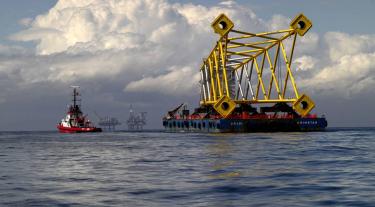Improved fatigue performance, through standardised high-quality welding conducted by robots, could enable offshore wind jacket foundations to last longer or potentially to use less steel, thus having the potential to reduce the weight and cost of the structures.
The analysis, conducted by the Belgian Research Centre for Application of Steel (OCAS), is a joint industry project and part of the Carbon Trust’s Offshore Wind Accelerator (OWA).
The project ‘Improved Fatigue Life of Welded Jacket Connections (JaCo)’, launched in 2017 and concluded at the end of 2023.
In addition to showing the possible benefits of robotic welding the JaCo project also showed the efficacy of accelerated fatigue testing method developed by OCAS, which is around 20 times faster than conventional fatigue testing methods.
Fatigue is a critical design factor for offshore wind foundations, which represents a large proportion of a wind farm’s CAPEX.
Marc Vanderschueren Head of Business Development at OCAS said:
“The importance of JaCo is twofold: the project has fatigue tested large-scale offshore foundation specimens, and the results have established new ground towards successful implementation of robot welding in jacket node fabrication.”
Offshore wind jacket foundations, used for deeper water and larger turbines, are currently welded manually, however, if the jackets were robotically welded industry-wide it could potentially improve weld quality and the consistency of the welds. Ultimately, this could lead to an increase in production and standardisation, with less steel needed, resulting in lighter structures – cutting costs and carbon emissions.
This is particularly important as according to the IEA, an additional 70-80GW of offshore wind capacity needs to be installed globally every year from 2030 to achieve Net Zero by 2050.
James Sinfield, Technology Acceleration Manager at the Carbon Trust said:
“The results from JaCo strongly suggest that automation can play a crucial role in the accelerated deployment of offshore wind, with automated robotic welding proving at least as good as — and often better than — manual welds.
“The project has exceeded our initial expectations, and results will enable the industry to produce structures that could last longer or potentially weigh less than existing foundations. Not only that, but the method pioneered by OCAS and tested via the JaCo project speeds up the testing process producing results equivalent to traditional hydraulic fatigue testing.
“This is good news for the Net Zero transition and demonstrates the power of collaboration. The combined efforts of our industry partners and trusted experts were pivotal to the success as they helped shape the project's direction and overcome challenges, along with significant input and engagement from the supply chain.”
Before robotic welds could be rolled out industry-wide, their fatigue performance needs to be better understood such that guidance for fabricators can be developed and for understanding how the new welding techniques may impact the existing standards.
This phase of the JaCo project represents the first stage of this process, with extensive mechanical testing carried out on 26 large-scale geometries to prove the consistency of robotic welding.
The next stage will require work with the certification bodies to translate the JaCo results into industry-wide acceptable practice, including creating industry guidelines and clarifying the conditions in which robotic welding outperforms manual processes.
This will help with adoption of robot welding and the new fatigue testing methodology throughout the sector.
JaCo is led by the OWA and OCAS, in partnership with developers EnBW, Equinor, ScottishPower Renewables, Ørsted, Siemens Gamesa Renewables, Shell, SSE and Vattenfall.
The Scottish Government, European offshore wind supply chain and three certification bodies are also involved.
ENDS
Notes to editors
For further information please contact: The Carbon Trust press office on +44 (0)20 7170 7050 or press@carbontrust.com.
About the Offshore Wind Accelerator (OWA)
The Offshore Wind Accelerator (OWA) is the Carbon Trust’s flagship collaborative research, development and demonstration (RD&D) programme. Set up in 2008, the programme aims to reduce the cost of offshore wind, overcome market barriers, develop industry best practice and trigger the development of new industry standards. The current phase involves participation and funding from nine international energy companies: EnBW, Equinor, Ørsted, RWE Renewables, ScottishPower Renewables, Shell, SSE Renewables, Total Energies, and Vattenfall.


